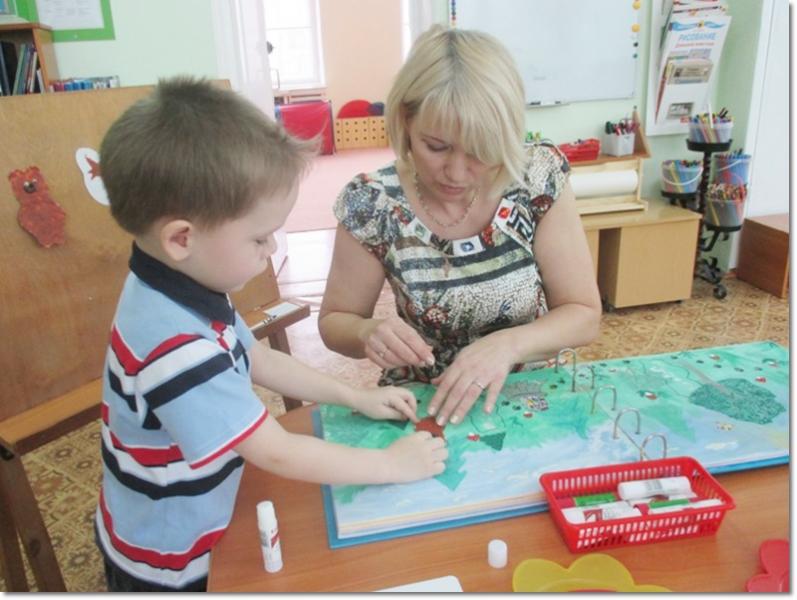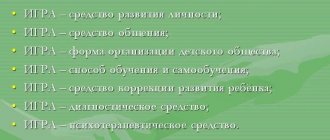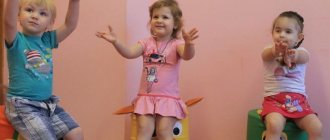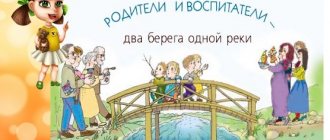Individual approach to raising and teaching a child in a kindergarten
The involvement of parents and other family members in the educational work of the kindergarten is necessary, first of all, for the children.
The success of cooperation largely depends on the mutual attitudes of the family and the kindergarten (V.K. Kotyrko, S.A. Ladyvi); they develop most optimally if both parties realize the need for targeted influence on the child and trust each other.
Positive results in raising children are achieved with a skillful combination of different forms of cooperation, with the active inclusion in this work of all members of the preschool team and members of the pupils’ families.
The forms of work can be very different - these are visits to families and children, open days, conversations, consultations, parent meetings, parent conferences. But priority remains with the individual form.
Thus, the following conclusions can be drawn: 1. Work both with the entire team of parents and individually with individual families can be successfully carried out only on the basis of knowledge of the characteristics of life and raising children in the family. 2. Factual material on the study of raising children in a family makes it possible not only to find out living conditions, but also to establish the reasons for the formation of individual qualities of children, to identify the connection between the conditions of upbringing, the formation of behavioral characteristics and the specifics of their manifestation. 3. Positive results in working with families can only be achieved if parents and educators reach unity of requirements in relation to children and all work is carried out according to plan and systematically. 4. It is necessary to give parents specific information on the issue of the age and individual characteristics of children, teach them to see the good in their children, and analyze the bad in their actions. 5. Along with general and individual forms of work with families, you can also work with several families that have similar conditions for raising children. 6. Studying the characteristics of family upbringing, as well as studying the characteristics of the child’s physical development, is a necessary condition for starting systematic work to implement an individual approach to children in raising and teaching them in various types of activities.
2. Psychophysiological aspects of an individual approach in the process of training and education.
In this test we will consider what psychophysiological aspects a teacher needs to take into account when taking an individual approach in the process of raising and educating a preschool child. The first aspect is the level of mental development. This aspect is one of the most accepted in pedagogical practice. When implementing an individual approach in the process of education and training in a kindergarten, the level of skills of the child, as well as the set of mental operations formed in the process of their acquisition, are traditionally studied. If the child’s mental development proceeds at an accelerated pace, this means that mental operations corresponding to his chronological age, he quickly perceives and comprehends the material, remembers and reproduces it faster, retains it more firmly in his long-term memory, and successfully uses the acquired knowledge in completing tasks. Cognitive interest here is very stable; it supports the child’s activity for a long time. An individual approach to raising and educating a child based on the level of his mental development today can only be built taking into account the zone of proximal development. In this case, the teacher differentiates not the task, but the measure of assistance to the child in completing it: some perform it independently and explain the progress to their friends or look for a rational way to complete it, others perform it according to a certain algorithm specified by the teacher and compose the same task, and still others receive step-by-step help with implementation. In this case, the task is the same in complexity for everyone. To organize such an individual approach to learning, it is not enough for a teacher to simply determine the amount of knowledge the child has; it is necessary to know the characteristics of his cognitive sphere, the maturity of cognitive actions and the level of the child’s learning ability. The second aspect is the type of nervous system. The individual characteristics of children can also be determined by the properties of the nervous system. According to modern concepts, the properties of the nervous system are of a genotypic nature and in this sense are understood as practically unchanged, stable characteristics of a person. This means that one cannot ignore individual typological characteristics and take them into account in pedagogical interaction. Among the main properties of the nervous system are the following: strength-weakness and mobility-inertia of the nervous system. The third aspect is the type of thinking. Children, like all people in general, think differently: for some, abstract, verbal-logical thinking prevails over figurative thinking. In this case, it is legitimate to talk about an analytical, “mental” mindset. In other people, imaginative thinking or, in other words, an artistic type of thinking predominates. For still others, the figurative and abstract components of thinking are in relative balance (harmonious mindset). These differences are based on the functional asymmetry of the cerebral hemispheres. The specialization of the hemispheres is facilitated by active mental activity, which in turn depends on how the work of the hemispheres is organized in the process of thinking. When implementing an individual approach, it is important for the educator to know which hemisphere provides the process of mental work and how, in order to effectively organize the process of training and education. Thus, the artistic type, that is, people with a dominant right hemisphere, is characterized by thinking based on vivid images that arise as a result of vivid perception and emotions. They think synthetically, grasping the entire object. They begin to comprehend the material with emotional inclusion, rely on ideas and images, and then move on to analyzing the components and drawing conclusions. In children of the thinking type, on the contrary, the thinking process begins with the analysis of components, with the construction of logical chains. They think in concepts, symbols, abstractions and logical reasoning predominate in them, and emotional coloring most often prevents them from thinking. It is pointless to talk about which type is better, since we are talking about the individual characteristics of a person. It is absolutely necessary to take them into account in the process of training and education. The fourth aspect is the Leading modality of perception. By observing the behavior of children, one can be convinced that the child’s way of understanding the world around him has a direct impact on the ability to adapt in society, on his physical development and, in the future, academic success. Knowing how a child learns about the world, one can with amazing accuracy assume or predict the problems that he will encounter in the future when studying at school. Considering that the way of cognition can be determined even in infancy, we can conclude that it is an innate characteristic of a person. Consequently, determining a child’s way of knowing is of great practical importance for parents, educators and psychologists, since it allows them to structure activities, games, and the learning process in such a way as to extract maximum benefit and pleasure from them and contribute to the development of the child. Thus, the following types of information perception can be distinguished: visual, auditory, kinesthetic. Visual type - the child learns through visual perception of information; auditory - through the perception of information by ear; kinesthetic - through the perception of one’s own activity. It is known that the priority of one or another way of cognition does not depend on age. A child's way of knowing will remain dominant throughout life, but empowerment only helps him make progress in each specific area. The fifth aspect is the state of health. The need for an individual approach to organizing the education and upbringing of children with physical defects and disorders of somatic development is beyond doubt today. However, psychological characteristics such as school neuroses, anxiety, fears, self-doubt and others are not always taken into account. Underestimation of these individual psychological differences and psychophysiological characteristics of children causes colossal harm to both the physical and mental development of the child. It is important for the teacher to know that in this case we are talking about mental health disorders, which are primarily associated with:
Scientific principle
Real knowledge must be provided while teaching a young child. You cannot simplify the material to the point of being schematic or distort it. A child remembers all information between the ages of 2 and 7 years. If the base is incorrectly formed, the child’s ideas will be greatly distorted.
The principle of science in the study of nature
In the process of teaching a child, specific ideas and knowledge about the world around him should be formed. All knowledge acquired should not conflict with the school curriculum. Didactics deals with this problem when teaching children of primary preschool age. She tries to prepare educational material in such a way that it is understandable to young children, but has a correct scientific basis. A thorough study of the curriculum for preschool children helps to create a powerful base on which it will be easier to string all school material.
Features of the scientific approach in the process of education are the formation in children of a unified picture of the world and a correct understanding of the laws of nature. It is very difficult to indicate the age of a child when basic concepts of the universe are formed. Many representatives of preschool education are inclined to believe that these basics should be an integral part of the education process.
From a very early age, children need to form correct ideas about the world around them, based on modern scientific knowledge.
The principle of the relationship between training and development
These two processes are interconnected and continuous, but at the same time they require patience. Just yesterday the baby couldn’t do anything, but today he is mastering different skills. All this is natural and natural. If at any stage in your training there are difficulties, you just need to be patient and move forward.

The relationship between learning and development in preschoolers
It is very important to awaken in a child a desire for independent knowledge, then the child himself will strive to learn new and interesting things.
Be sure to praise your child and create a situation of success - this is the surest incentive. Love children, then you will certainly succeed. leave a comment
The principle of active participation in the learning process
Features of the principle - only the knowledge that has aroused the child’s interest and active participation in its assimilation is acquired. If the child does not care about what is happening, then information received from the outside will pass by and not be perceived by the brain.

The child must take part in learning
While working with children, the teacher must provide techniques that activate interest in knowledge and thinking. The fact that the child receives information chewed up in detail, the assimilation of which does not require his time and energy, has a negative impact. It may seem simple and understandable, but the lack of personal involvement makes it distant and uninteresting. There needs to be a balance in the parenting process.
Cognition should be the solution of practical problems, activity, independence. The basis of such ideas is the indicative-exploratory reflex.







